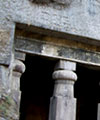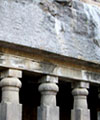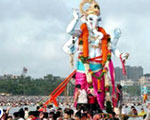| Encyclopedia of Tours and Travel to Maharashtra, featuring information on Fairs & Festivals, Wildlife, Excursion, Adventure and Weather of Maharashtra. |
 |
 |
 |
 |
 |
 |
 |
||
|
Ganapatipule
Ganapatipule > General Information > Places to Visit
[ Theeba Palace | Malgund | Jaigarh Fort | Pawas | Ratnagiri | Velneshwar | Marleshwar | Derwen | Parshuram Temple | Ganapatipule Temple ] Theeba Palace Malgund It is a small peaceful village about 1km away from Ganapatipule. The poet's house was recently renovated and converted into a student's hostel. The Marathi sahitya parishad (Marathi literature society) has constructed a beautiful monument called Keshavesoot Smarak in the memory of the great son of the soil. Jaigarh fort Pawas
Ratnagiri Velneshwar
Marleshwar Derwen Parshuram Temple Ganapatipule Temple Ganapatipule, on the western coast of Maharashtra, is well known for the unique idol of Lord Ganapati housed in the splendid 400-year-old Swayambhu Ganapati temple. The meaning of Swayambhu is self-created or that which has come into existence by itself and is not manmade. Ganapatipule derived its name from Ganapati or the lord of ganas or army and pule meaning sand dune. Legend has it that during sixteenth century AD, a farmer seeking refuge from the skirmishes around his tiny village, arduously made his way through the Kerda jungles and stumbled upon the Swayambhu idol of Lord Ganapati, around which he made a temple. For four hundred years thereafter, generation upon generation of villagers, who came from elsewhere and started living there, cared for and added to the shrine and mage if into the temple one sees today. The peculiarity of this temple is that the deity faces the west, so as to guard the western dwar (door or entrance). Unlike deities in other Indian temples, which face the east. The temple is at the foot of a hillock and pilgrims believe that in taking a pradakshina around the hill instead of just the temple, is more auspicious. Pradakshina is a way of showing obeisance by walking around the idol of the deity or the temple in which the idol is housed. In the past couple of years, Ganapatipule has seen a sharp rise in the number of visiting tourists, primarily because of the temples in and around here. People from nearby Mumbai find it a convenient place to visit on a short holiday during the weekend. The Konkan Railway line that connects Maharashtra, Goa and Karnataka, follows an astoundingly beautiful trail through the picturesque west coast. It's a great idea to take this railway line to Ganapatipule. All you have to do is just sit back and enjoy the scenery. The road is also an equally good bet. In fact, traveling to Ganapatipule by road is a vacation in itself. If you take the highway from Bombay, Ganapatipule is only 375 kilometers. The nearest airport is Ratnagri, 50 kilometers away. The entire Konkan region is a paradise - for miles and miles there is something new to discover, in whichever direction you go. Narrow roads, red soil, tile-roofed houses, clean courtyards and innumerable fruit - bearing tress (including mango, betel nut, banana, jackfruit, etc.) are a pleasing sight. Ganapatipule has an Old World charm about it that comes alive with a true rustic flavor, which one discovers on your visit. Fine, sifted, silver sands; a gentle lapping sea; wooded hills, yet untouched by man's destructive axe and a secluded township, make Ganapatipule a quiet, peaceful retreat, laced with the unforgettable aroma of fruits, flowers, mangroves and swaying coconut trees. Marathi is the most widely spoken language along with a dialect of Konkani. You can discover innumerable secrets about the place meeting the friendly and hospitable Konkanis and chatting with them. Only the natives of this naturally gifted countryside are familiar with the truly beautiful spots. Besides festivals like Holi, Gudi Padva and Diwali, Gauri Ganapati, Magh Chaturthi and Dashavatar are the most important religious events celebrated not only in Ganapatipule but the entire Konkan region. According to the local people, Magh Chaturthi falls on the fourth day of the lunar month of Magh, and that which coincides with the month of February is believed to be the actual birth date of Lord Ganapati. Rest and relaxation is the key to this offbeat place. You can amble along the peaceful beach, stroll through the village or wade across the shoals of a nearby creek or take boat rides upstream, sailing past swaying palm trees and jungles. The 'Konkan' region is blessed with some of the finest horticulture. Bye-products of fruits offer you a typical variety of local preparations. Like ambapoli (thin pancakes of dried and crushed mango), phanaspoli (thin pancakes of dried and crushed jackfruit) is also a special treat as also cashewnuts, fried and salted. If you are in Ganapatipule in summer, do not leave without feasting on the most delicious and world famous variety of mangoes - the Devgad hapus. Since Ganapatipule is a pilgrimage destination, you may not get non-vegetarian food here. But on the outskirts of the village, local fish curries with rich and kokum kadi, (a ping colored concoction prepared with kokum and coconut milk) is a real treat. Kokum is a dark purple black, fruit. The fruit is often halved and dried and is usually available as a dried rind, resembling a thick plum skin. When added to food, it imparts a pink to purple color and a refreshing sour taste, slightly astringent. Kokum has the same souring qualities as tamarind, especially enhancing coconut - based fish curries or vegetable dishes. It is also included in chutneys and pickles. 'Kokum kadi' is a highly digestive drink and neutralizes all effects of spicy food. A glass of cold kokum sherbet is the best way to quench your thirst in the parched summer months. Besides fabulous beaches and ancient temples, Ganapatipule affords a number of opportunities for excursions into the remote fishing hamlets, village and towns of the Konkan region. The entire coastline is breathtakingly beautiful with pristine beaches, overhung by cliffs and interspersed by little creeks. Isolated lighthouses light up the ruins of forts built during the reign of the Maratha ruler Chhattrapati Shivaji. Pawas and Marleshwar are also places you must not miss during this tour. Besides its natural beauty and serenity, Pawas achieved prominence when Swami Swarupanand (a spiritual leader who influenced an entire generation of Maharashtrains) made it his abode. The place where he used to reside is now converted into an ashram. A visit to this Ashram even today is like a journey through time. Our next stop was at Marleshwar, barely an hour's drive from Pawas. Close to the Marleshwar temple, which is situated in a cave, is the Dhareshwar waterfall. On Maker Sankranti every year, people of Konkan celebrate Marleshwar Yatra near Devukh. On this day, the wedding of Lord Marleshwar with goddess Girijadevi is celebrated. An amazing fact about this temple is that despite the presence of many snakes in and around the temple, no devotees have been bitten. This has resulted in an increase in the faith and number of devotees. This place presents a breathtaking view of the Sahyadri mountain ranges. The Government is now developing this locale as a tourist spot. So this is the right time to take a quick holiday and enjoy the natural beauty of this place before the crowds start pouring in. There is no limit to the natural beauty and one can go on and on feasting on the charm of the Konkan region. But we realise that it is time to pack up and return to the routine of our mundane daily life. The small village of Ganapatipule lies on a vast stretch of the silvery coast of Maharashtra. The main attraction here is the 400-year-old Ganapati idol in the Swabhimanyu Temple. The Temple is at the foot of a hill adjacent to a glorious beach. The hill itself is considered sacred and a perennial spring flows from the hill to a pond besides the Temple. During 16th Century AD, a villager, fed up with frequent quarrels in his village, escaped to the Kerda jungles. On his way there, he stumbled upon a naturally formed Ganapati idol. Seeing this as a good omen, he built a temple there. As the word spread, people gathered and gradually even settled there. They worshipped the idol, performed prayers and made additions to the shrine. This was 400 years ago. Over time, the fame of this small temple has increased manifold, listing it on the map of the holy. The local people of the area believe that in an age when men were spiritual and miracles were a common observable fact, the scriptures talked of four Dwardatas (Welcoming Deities) to the subcontinent, where Ganapatipule is one of the ashta (eight) Ganapatis of India and is known as Paschim Dwaar Devata (the Western Sentinel God). Swayambhu Ganapati Temple is known for their unique idols of Ganapati built on pule (white sand). It is swayambhu (self-originated) and not manmade. The idol of Ganapati is made out of copper and depicts the God astride a lion. It is placed in the Garbhagriha (Sanctum Sanctorum) and at sunrise and sunset; a shaft of golden light penetrates and illuminates the idol. Early in the morning, the rhythmic beat of the nagaras (a percussion instrument) can be heard from the Temple. The chaughadas (percussion instruments) are played in the evenings at the time of changing the idol's clothes and naivyadham (sweets) are offered to Ganapati as mantras (holy sayings) are read aloud. Festivals: Ganesh Chaturthi: The climate here is moist and humid. From March onwards, the temperature begins to rise with May being the hottest month. Monsoons last between June and October. The remaining months is very pleasant. Ganpatipule is named after its most famous attraction the temple dedicated to Lord Ganesh. However, Ganpatipule is much more. With silver beaches, sparkling water and a local attitude of total naiveté, this archetypal Indian coastal village promises you a refreshing getaway. The beaches in Ganpatipule are really idyllic: wide stretches of powder white sand set against pristine green hills, lush orchards and gushing creeks. Just perfect for somnolent hours spent lazing on the sands and watching the life go by in this beautiful coastal hamlet. Ganpatipules star appeal the 400 year old temple made from a single massive rock and housing the swayambhu Ganpati, a natural formed idol, is a must visit for pilgrims and tourist alike. While in Ganpatipule, accommodate a daylong excursion to the Jaigad beach and fort of the Velneshwar Temple. And with Ratnagiri, home of the Alphonso mango being nearby, visitors to Ganpatipule in summer can reap an additional bounty.
|
|||||||||
|
|||||||||
|
|||||||||
|---|---|---|---|---|---|---|---|---|---|